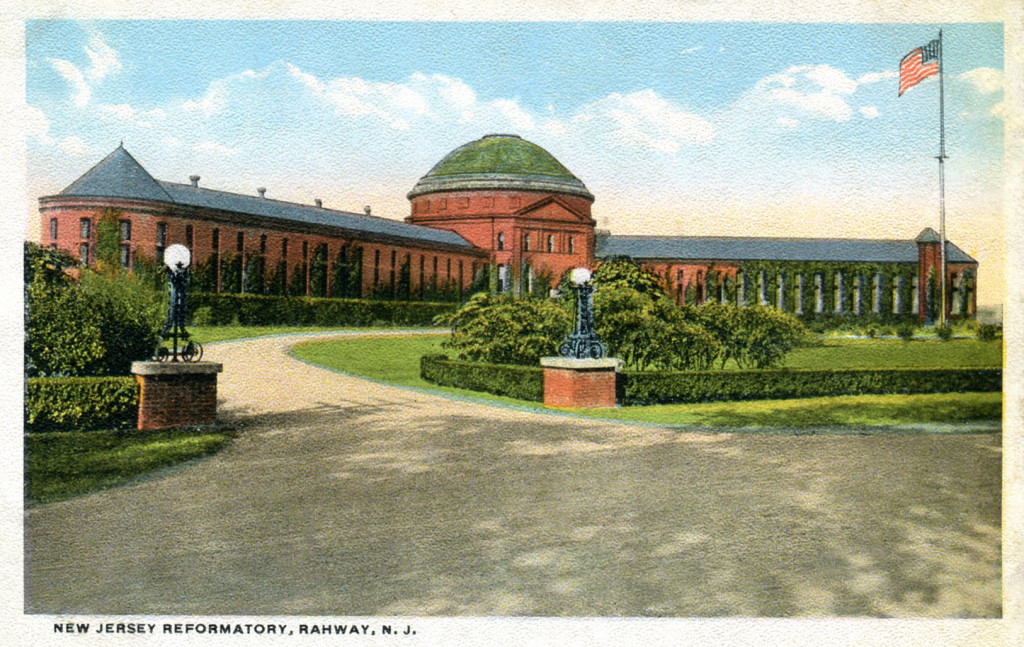By Al Shipley, City Historian and Rahway Library Research Consultant
Mention the name East Jersey State Prison and most wouldn’t have a clue to what one was referring. Mention Rahway Prison, however, and there’s a very good chance most people, even those living in states across the country, have heard of the notorious penal institution. For Rahway citizens, the name “Rahway Prison” has been a point of contention from the time the facility was opened.
In 1895 the New Jersey Legislature voted to establish the state’s first reformatory to be built for young men between the ages of 16 and 30 who were found guilty of a first offense. The purpose was to provide a place where young men could be sent that would give them the greatest possibility to reform. The site chosen for the reformatory was a 300 acre tract of state-owned land located in the Avenel section of Woodbridge Township, Middlesex County. At the time, Avenel, which did not become an established community until 1901, was for the most part farmland and open space. Construction took three years and the facility opened on August 1, 1901. The new structure, with its large imposing dome and distinctive architecture, immediately became the most prominent landmark in the area.
The building complex encompassed 21 acres and included an administration building, cell houses, school rooms, a chapel, and other buildings which were surrounded by a large wall. Within the enclosure were athletic fields for baseball, football, softball, and soccer. The entire prison was surrounded by hundreds of acres of farmland that the inmates worked.
With rehabilitation being the primary purpose, a well-balanced and properly supervised program was offered. Vocational training included tailoring, cooking, shoemaking, printing, electric work, farming/gardening, plumbing, and painting. Complete medical, psychological, and psychiatric facilities were provided. Attendance at religious services, offered for Protestant, Catholic, and Jewish inmates, was strongly encouraged, but optional.
By the late 1920s, with the construction of reformatories at Annandale and Bordentown, Rahway was upgraded and changed from a reformatory to a prison for adult males. Today, the maximum security penitentiary houses over 1,500 inmates.
From the time the reformatory opened in 1901, the name “Rahway” quickly became attached to it even though it was not in the city of Rahway nor was it even in Union County. Due to the fact that it was situated in rural, undeveloped Avenel, all mail sent to the facility was processed through the Rahway Post Office. Also, anyone visiting the reformatory via the railroad would alight at Rahway Station.
The consternation felt by Rahway citizens regarding the reformatory and later the prison is nothing new and has rankled residents from the time the institution received its first inmates. In a letter written to a local newspaper in 1927 a Rahwayan wrote in part, “Rahway is the target for all kinds of witticism and receives much unfavorable criticism because of the misuse of the name… Outsiders probably have the idea that the outstanding feature of Rahway is the reformatory; that it occupies a site in the heart of the city; and that the whole business life of the city revolves around the institution… Certainly, being known as a reformatory town does not add to the attractiveness of a place. Indeed, it might very well prove a hindrance to the development of a town.”
In the late 1970s and into the 1980s, an aggressive effort was finally made by city officials to get the name changed. On February 8, 1982 a resolution was introduced to the city council by Third Ward Councilman Max Sheld requesting the New Jersey Department of Corrections to give the facility an official name “that does not identify it with any geographical location.” Five months later the Rahway measure passed through the Assembly by a vote of 49-17. Legislators agreed that “By assigning a more regionalized name to the prison, we can hopefully prevent its proximity from distracting from the desirability of nearby communities.” The wheels of government turn slowly, however, and it was not until five years later, on November 30, 1987, that a law was signed by Governor Thomas Kean to change the name to East Jersey State Prison.
Although the new name has officially been in use for almost 30 years, hardly anyone is heard referring to the place as East Jersey State. Unlike the Merchants and Drovers which is fondly remembered as the Girl Scout House or the Union County Performing Arts Center as the Rahway Theater, Rahway Prison is a term void of nostalgic sentiment. Unfortunately, it will probably take a few more generations before the misnomer is totally forgotten.






